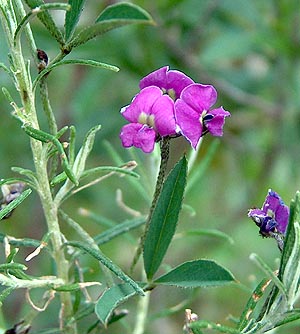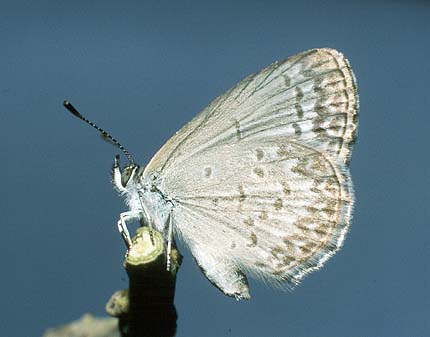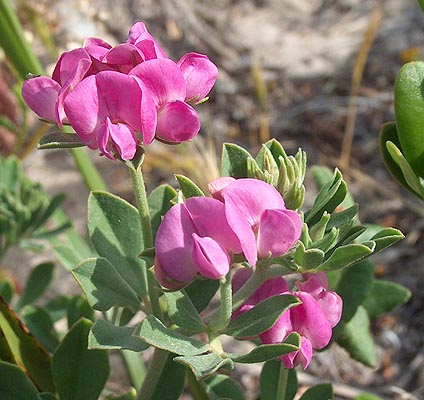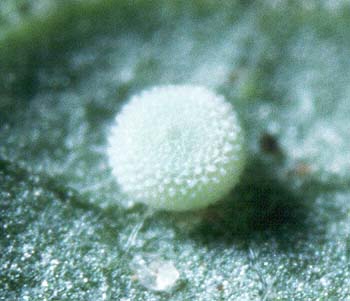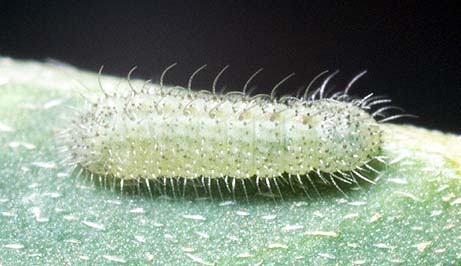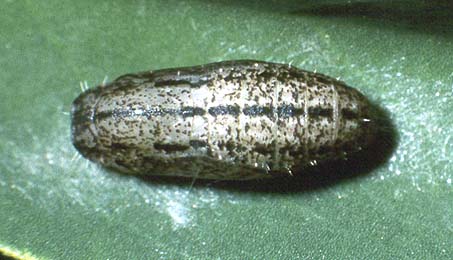-
Larval Food Host
-
Larvae feed on numerous native and introduced legumes, usually small herbs and plants from
the Fabaceae family including
Crotalaria eremaea strehlowii (smooth loose-flowered rattlepod),
Cullen (Psoralea) australasicum (tall scurf-pea),
C. microcephalum (mountain scurf-pea),
C. pallidum (white scurf-pea),
C. patens (spreading scurf-pea),
Daviesia brevifolia (leafless bitter-pea),
Glycine spp incl. *G. max (soybean),
Glycyrrhiza acanthocarpa (native liquorice),
Hardenbergia violacea (native lilac),
Indigofera spp (indigo's) incl. I. australis (austral indigo),
Lotus spp incl. L. australis (trefoil),
L. cruentus (redflower trefoil), *Lupinus sp (lupins),
*Medicago spp (lucernes, medics) incl.
M. sativa (lucerne or alfalfa),
*Phaseolus spp incl. *P. vulgaris (garden bean),
*Pisum sativum (garden pea),
Pultenaea tenuifolia (narrow-leaf bush-pea),
Sesbania cannabina (sesbania pea),
Swainsona spp (darling or swainson peas),
*Trifolium spp (clovers), *Trigonella spp (fenugreeks),
*Vicia faba (broadbean),
Vigna lanceolata var. latifolia (maloga bean),
*Virgilia oroboides (Cape virgilia).
In the Far North of South Australia they also utilise
*Acacia farnesiana (mimosa or sweet acacia) (Mimosaceae).
The larvae will eat the flowers, leaves and the immature seeds within developing seed pods.
-
Larval Attendant Ant
-
Larvae are usually attended by a few ants, including
small black ants Iridomyrmex sp,
Rhytedoponera sp, Tapinoma sp,
or a small dark-brown ant Paratrechina sp,
or additionally in the Far North by the large black meat ant
Iridomyrmex viridiaeneus
or the large black sugar ant Camponotus capito.
-
Eggs
-
Small, initially pale green, later turning bluish white, hemispherical, strongly flattened
top and bottom, slightly depressed on top with a small darker central micropylar area.
Ornamented with a coarsely reticulated pattern on the side which becomes finer on top.
The reticulation facets on the side are trigonal, which are grouped together in an orderly
fashion to form large hexagons.The facets on the top of the egg are much smaller and are of
irregular shape. There are short, thick, blunt spines at the pattern intersections on the
side of the egg, which are absent on the top of the egg. Laid singly on the foodplant, which
can be the flower buds, open flowers, leaves and other softer green parts. Eggs are sometimes
so common on the foodplant as to produce a fine speckled appearance.Eggs take about four days
to develop in spring.
-
Larvae
-
The first instar is initially pale yellow, changing colour after eating the foodplant,
with long lateral and long recurved paired dorsal hairs.The head is black. Newly emerged
larvae prefer to eat the flower petals. Older larvae will eat both flower petals and green
parts of the foodplant. In subsequent instars the larvae become covered in secondary setae,
and the long hairs become progressively shorter with each instar. Larvae require five
instars in temperate areas but can develop with four instars in the hot Far North areas of
the state.
The mature larvae are about 12 mm long, onisciform (slater shaped) with an indistinct
longitudinal dorsal furrow.The head is small, smooth, dark brown, hidden beneath the
body. The body has some short lateral and dorsal hairs, and is covered in numerous,
pale coloured, minute secondary setae having a stellate base and a long erect or
recumbent serrated and pointed central spine. The secondary setae impart a scabrous
appearance to the larvae. The posterior dorso-lateral organs are well developed.
The larvae are polymorphic (i.e. they occur in many colour forms). Larvae colour and
markings are highly variable, being some shade of greenish white, green, pink, purple
or brown, or combinations thereof, with a darker longitudinal dorsal line and adjacent
forward directed chevrons, a hatchured subdorsal line, additional lateral markings and
a pale yellowish white lateral line. The colours are cryptic and usually blend in with
the portion of the foodplant they are eating. Green coloured larvae predominate. Larvae
feed openly during the day. The presence of larvae on the foodplant is readily discernible
by holes in the buds, flowers and seed pods, and by the scouring of the leaves. Small
ants are usually indicative of the position of actively feeding larvae.
Larvae are sometimes carnivorous, practising cannibalism on its own kind, although it
is usually very rare in this butterfly under natural conditions. It occurs when the
larvae are so prolific on the foodplant that they quickly consume all of the edible
parts. Some of these larvae are able to pupate even though not fully developed,
producing smaller than normal flying adults. Others may devour either smaller
larvae, particularly those undertaking a moult, or larger larvae undertaking
pupation. Fully hardened pupae are not eaten due to their tough outer case.
This cannibal tendency occurs in many Lycaenid species, particularly those species
which lay large numbers of eggs on foodplants of small stature.
Larvae of this species often accompany those of Lampides boeticus
on the same foodplant, in which case the latter usually eat the flower ovary and seed pod contents,
while the former eat the leaves and flower petals.
-
Pupae
-
Short cylindrical, rounded anteriorly and posteriorly, about 8 mm long, mostly smooth with
a few short bristles which are longer and more common on the anterior and posterior parts
of the pupa. Polymorphic with individual pupae occurring in various shades of green, grey,
pink or brown, and sometimes white or yellowish, speckled with darker markings, and with a
dark brown or black dorsal line and a broken subdorsal line. When newly pupated, the pupa
is usually subtranslucent greenish grey or white, later turning brownish grey or brown with
age, but sometimes the pupae remain pale coloured dependant on the substrate colour onto
which they have pupated. Weakly attached by anal hooks and a central girdle, often to some
green part of the foodplant, or to leaf debris beneath the foodplant. The pupating larva
will sometimes loosely web together a folded leaf or two leaves, within which it will pupate.
The pupal period is variable. It can be as short as 16 days in temperate summer areas,
extending to a month in early winter, or it can overwinter until the warm spring weather
arrives. In the Far North the pupal period is 14 days in spring.
-
Flight Period in South Australia
-
It is possible to find flying butterflies throughout the year, depending on the area.
In the Far North pastoral areas it is more common after rainy periods as its foodplants
respond to the moisture with new growth and flowers. In the southern areas it is common
during the warmer months, but is also sometimes seen flying in winter during warm, sunny
breaks. There are continuous broods over the warmer months, which are completed in less
than 10 weeks in southern temperate areas, extending to 13 weeks in late autumn. Less
than 7 weeks are required in the hot Far North areas of the state.

-
Distribution
-
Occurs throughout Australia, including Kangaroo Island and Tasmania.It has migration
tendencies, typical of the Polyommatini group of lycaenids, although no obvious
migrations have been reported from South Australia. This is supported by its uniform
adult morphology throughout Australia.
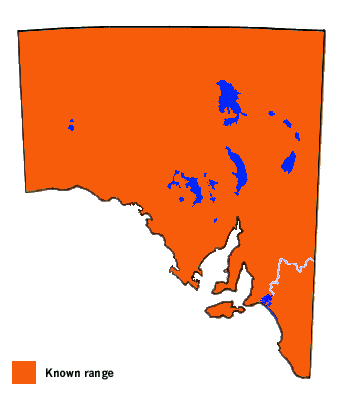
-
Habitat
-
Found wherever its foodplants occur, and these are
common and widespread occurring in most habitats.
-
Conservation Status in South Australia
-
Locally common in breeding areas.
-
Threats
-
No major threats.
-
Conservation Strategy
-
None required.Thrives in urban gardens. Sometimes considered a pest due to
the fondness of its larvae for low growing leguminous crops and vegetables.



